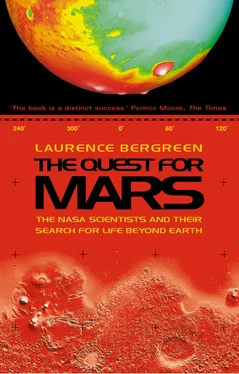Jim points to the volcano’s peak looming overhead and recollects the last time he climbed it. “The wind was blowing at forty-five miles per hour the whole time, and it was very hard even to talk.” That windspeed was moderate, by Surtsey standards; the island endures 200 days of gale-force winds a year. “When we were here in ’91, this area was a desert, but plants are taking over now.” Now, the main plant in evidence is the lowly sandwort, a simple succulent that has proliferated on Surtsey with astonishing speed; small, dense, and tenacious, it can boldly go where other vegetation can’t. Even mosses can’t get a grip on Surtsey; the wind rips them out of the ground and flings them away.
“Look! There is a gorgeous breccia. Notice it’s in a little hollow, okay? That’s called an apron. We look for those kinds of things on Mars. Outside, you can see there’s a layering to it that’s caving in. See the carapace of lava up there? It’s starting to break off. In a big storm, that could fall.” It looks like the burned crust of a pie at the edge of a pan. “Now, see how these rocks are perched? Notice the pits. That’s where Mars comes in.” You see something similar in images from Pathfinder, Garvin says – pits left by primary gas bubbles in the lava. He snaps a picture of the pitted rocks on Surtsey as he continues. “Look at these pitting textures! All different. It’s exquisite.”
He zeroes in on a block of lava that speaks to him in a private language. Crouching, he declares, “Now, this is not primary lava. It’s softer, and it’s been coated with a bright alteration stain caused by chemical weathering. It’s allochthonous. That means it’s out of place, been moved away.” I step back to take in the scene, and I realize the site looks like the Grand Canyon in miniature. “This could be the beginnings of a little Martian canyon system,” Garvin exults. “It’s gorgeous. Oh, God, wouldn’t I love to measure that with a laser!”
We’ve been picking our way around the base of the volcano, and now we turn away from it and face the ocean. Before long, Jim again shouts. “Look at that.” He points to a slight discoloration on a mound of stones, in which he sees vast implications. “That’s the high water mark from a wave, where the fine dust coated the rocks. Now that is the kind of shoreline we are looking for on Mars.” The subject of ancient shorelines on Mars carries the charge of controversy and borderline heresy. Several scientists have tried mapping the shorelines of ancient Martian oceans that vanished a billion or more years ago, but their work has yet to gain widespread acceptance. I try to imagine Mars as a wet place, covered with oceans, teeming with possibilities, but this is like trying to visualize oceans in the Sahara, for Mars is red and dry and cold.
A large empty plastic bottle catches my eye, disturbing my reverie. The object seems as incongruous here as it would on the surface of Mars. We notice pieces of plastic, and buoys, and rope, and blocks of wood studded with rusty nails. “The garbage of humanity,” as Jim calls it, has drifted out here, fifty miles from nowhere, a mocking reminder of home. All day long, he has been scrupulous about not disturbing plants or lava or rocks, to the point of walking in old footprints. Avoiding the detritus, we cross a hard, crusty portion of the beach. “Hard pan clays,” he remarks. “See how they crack? They’re desiccated. We look for things like that on Mars. More indirect evidence of water. Here on Surtsey, we have a microcosm. We have a scale where it’s easier to see things. One of the things about Mars to remember is that it’s a big planet, about forty percent as large as Earth. If we land in three or four places on Mars, we’ll learn about them, but we won’t get the big picture of Mars that way, so we study sites on Earth that we believe operate in a similar way.”
We approach the water’s edge, but a formidable barrier repels us: a giant collection of round, basketball-sized rocks. “If we ever saw a field of dense, interconnecting rocks like this on Mars, we’d know the action of water was responsible. But, we haven’t seen this, yet.” As a geologist, Jim looks for patterns, distributions, colors, textures, and shapes. He is the detective, and they are his fingerprints. If he successfully unravels the geological mysteries of Surtsey with them, he will also know more about the development of the Red Planet.
Turning away from the beach, Jim and I finally begin the ascent to the volcano’s summit. I’ve been trying to put off this chore, but here it is, the thing we must do. Jim reminds me that we are climbing an active volcano, and there’s always a chance that it could blow without warning. I recall Iceland’s uninterrupted pattern of volcanic outbursts every five years for the last 1,100 years, and I remind myself that it’s due for another eruption. I feel as though we’re crawling up the side of a giant, overstressed pressure cooker. Jim tells me that a series of sensitive seismometers has been placed on the volcano; in fact, all the volcanoes in Iceland are similarly equipped, and the seismometers are so sensitive that they can detect microseizures involving magma, or molten rock. I’m somewhat relieved to hear about this detection system, but in the event of a warning, I wonder how anyone would be able to convey the news to us. Six months after our visit, a big volcano finally did erupt beneath Iceland’s largest glacier, Vatnajökull, located on the southeast coast, home to most of the country’s population.
The gray lava and rounded rocks give way to a smooth, steep incline. Jim estimates it’s twenty degrees, but it feels more like thirty to me, very steep, indeed. We zig-zag our way across, and look down on the larger of Surtsey’s craters, a craggy rusty red configuration filled with volcanic ash that from this height resembles a soft, inviting mattress. The wind picks up, and we crouch to avoid being flung down the slippery side of the mountain. Wind, incidentally, figures prominently in the Martian environment. On the surface, dust devils are everywhere. In the upper atmosphere, winds can reach 350 miles per hour, and wind storms occasionally engulf the entire planet, obscuring the surface for days.
Jim reaches a seep, a place where the ground comes apart, as if it were fabric that has been rent. A faint plume of steam rises from the wound, and the smell of sulfur permeates the air. Kneeling beside this smoldering, malodorous seep, I begin to think of Hell as a realistic notion, based on observable geology. Jim asks me to place my hand on the soil near the edge, and it feels like hot clay. A fine white crust along the rim contains bacteria that thrive in the heat and sulfur. This is the most primitive type of life on Earth, Jim reminds me. Life may have begun in volcanic seeps similar to the one at our feet, and it might have started the same way on Mars, on other planets, and on countless moons and asteroids – if it ever did.
These bacteria are examples of extremophile life, primitive life forms that have recently been discovered in places where biologists once assumed life could not survive because the conditions were too hostile – too hot, too cold, too dark, too salty, too deep. In recent years, many of the assumptions about the requirements for life on Earth – and, by implication, the possibility of life on Mars and other celestial bodies – have been overturned.
“We are finding out about the tenacity of life,” Jim said before the trip, “and it’s startling. We’re finding creatures that live at five times atmospheric pressure two miles deep in the ocean in places where the water would boil if there weren’t tons of pressure on top of it. We’re finding giant simple worms that look like garden hoses that live under those conditions. They don’t need any light, they scavenge the sulfur produced in volcanic eruptions deep in the ocean. They live off sulfur; they eat bacteria that grow in the sulfur, and that sustains them. Is there sulfur on Mars? Likely.” Life flourishes just about anywhere , it turns out, no matter how extreme the conditions. “Can you stick life a mile down in rocks and have it survive and bloom? Yes. Can you put it two miles deep in the ocean where there is no light of day, ever? Yes. Stick it on the coldest place on the planet and it will at least remain dormant there? Yes! Now, if you can form niches of life on Earth in such horrid environments, with pressure that would crush a human being to pulp and temperatures that would boil our skin – if you have life forms under those conditions, then it gets quite interesting. In fact, the question now in biology is: can you even produce a sterile environment?”
Читать дальше












